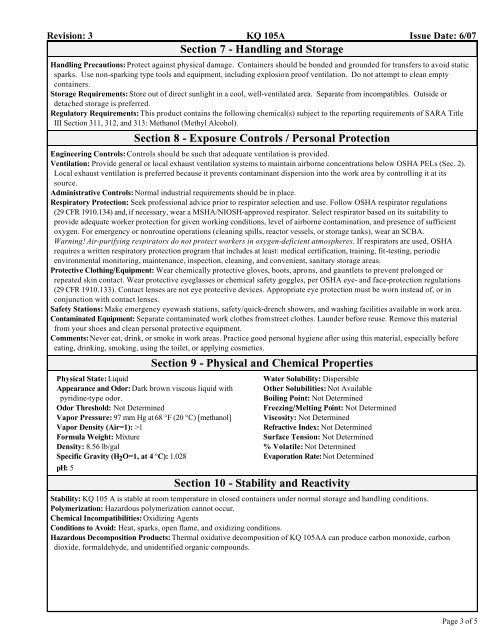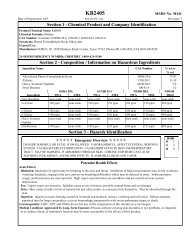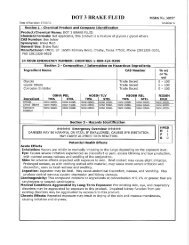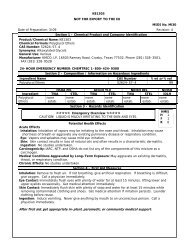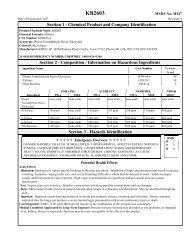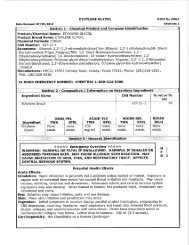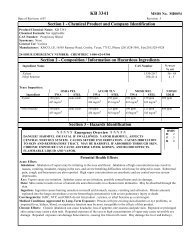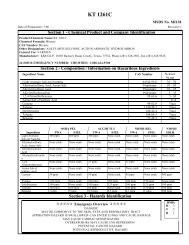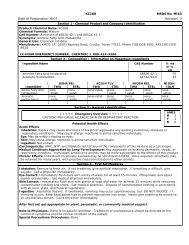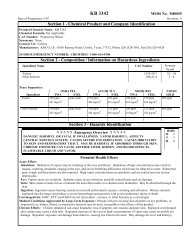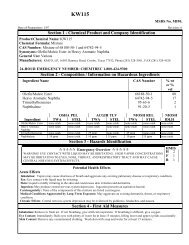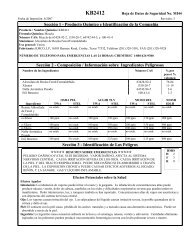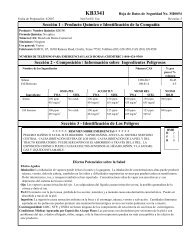Create successful ePaper yourself
Turn your PDF publications into a flip-book with our unique Google optimized e-Paper software.
Revision: 3 <strong>KQ</strong> <strong>105A</strong> Issue Date: 6/07<br />
Section 7 - Handling and Storage<br />
Handling Precautions: Protect against physical damage. Containers should be bonded and grounded for transfers to avoid static<br />
sparks. Use non-sparking type tools and equipment, including explosion proof ventilation. Do not attempt to clean empty<br />
containers.<br />
Storage Requirements: Store out of direct sunlight in a cool, well-ventilated area. Separate from incompatibles. Outside or<br />
detached storage is preferred.<br />
Regulatory Requirements: This product contains the following chemical(s) subject to the reporting requirements of SARA Title<br />
III Section 311, 312, and 313: Methanol (Methyl Alcohol).<br />
Section 8 - Exposure Controls / Personal Protection<br />
Engineering Controls: Controls should be such that adequate ventilation is provided.<br />
Ventilation: Provide general or local exhaust ventilation systems to maintain airborne concentrations below OSHA PELs (Sec. 2).<br />
Local exhaust ventilation is preferred because it prevents contaminant dispersion into the work area by controlling it at its<br />
source.<br />
Administrative Controls: Normal industrial requirements should be in place.<br />
Respiratory Protection: Seek professional advice prior to respirator selection and use. Follow OSHA respirator regulations<br />
(29 CFR 1910.134) and, if necessary, wear a MSHA/NIOSH-approved respirator. Select respirator based on its suitability to<br />
provide adequate worker protection for given working conditions, level of airborne contamination, and presence of sufficient<br />
oxygen. For emergency or nonroutine operations (cleaning spills, reactor vessels, or storage tanks), wear an SCBA.<br />
Warning! Air-purifying respirators do not protect workers in oxygen-deficient atmospheres. If respirators are used, OSHA<br />
requires a written respiratory protection program that includes at least: medical certification, training, fit-testing, periodic<br />
environmental monitoring, maintenance, inspection, cleaning, and convenient, sanitary storage areas.<br />
Protective Clothing/Equipment: Wear chemically protective gloves, boots, aprons, and gauntlets to prevent prolonged or<br />
repeated skin contact. Wear protective eyeglasses or chemical safety goggles, per OSHA eye- and face-protection regulations<br />
(29 CFR 1910.133). Contact lenses are not eye protective devices. Appropriate eye protection must be worn instead of, or in<br />
conjunction with contact lenses.<br />
Safety Stations: Make emergency eyewash stations, safety/quick-drench showers, and washing facilities available in work area.<br />
Contaminated Equipment: Separate contaminated work clothes from street clothes. Launder before reuse. Remove this material<br />
from your shoes and clean personal protective equipment.<br />
Comments: Never eat, drink, or smoke in work areas. Practice good personal hygiene after using this material, especially before<br />
eating, drinking, smoking, using the toilet, or applying cosmetics.<br />
Physical State: Liquid<br />
Appearance and Odor: Dark brown viscous liquid with<br />
pyridine-type odor.<br />
Odor Threshold: Not Determined<br />
Vapor Pressure: 97 mm Hg at 68 °F (20 °C) [methanol]<br />
Vapor Density (Air=1): >1<br />
Formula Weight: Mixture<br />
Density: 8.56 lb/gal<br />
Specific Gravity (H 2 O=1, at 4 °C): 1.028<br />
pH: 5<br />
Section 9 - Physical and Chemical Properties<br />
Water Solubility: Dispersible<br />
Other Solubilities: Not Available<br />
Boiling Point: Not Determined<br />
Freezing/Melting Point: Not Determined<br />
Viscosity: Not Determined<br />
Refractive Index: Not Determined<br />
Surface Tension: Not Determined<br />
% Volatile: Not Determined<br />
Evaporation Rate: Not Determined<br />
Section 10 - Stability and Reactivity<br />
Stability: <strong>KQ</strong> 105 A is stable at room temperature in closed containers under normal storage and handling conditions.<br />
Polymerization: Hazardous polymerization cannot occur.<br />
Chemical Incompatibilities: Oxidizing Agents<br />
Conditions to Avoid: Heat, sparks, open flame, and oxidizing conditions.<br />
Hazardous Decomposition Products: Thermal oxidative decomposition of <strong>KQ</strong> <strong>105A</strong>A can produce carbon monoxide, carbon<br />
dioxide, formaldehyde, and unidentified organic compounds.<br />
Page 3 of 5


